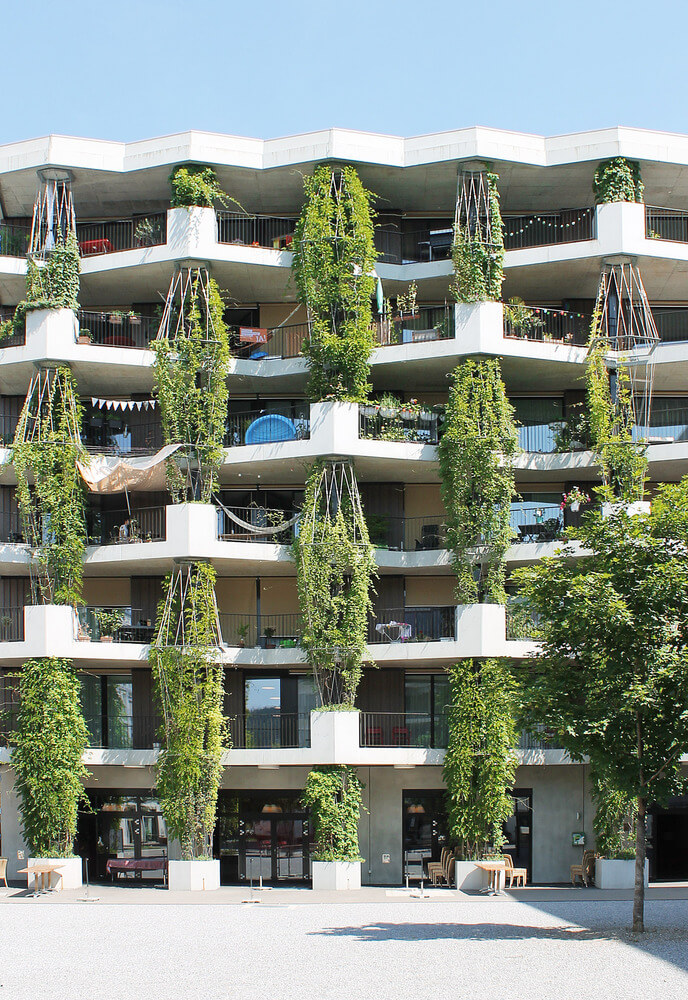Problem
Due to the heavy sealing of surfaces in cities, overheating occurs, which is referred to as the urban heat island effect. The reason for this is a lack of green and retention areas, which enable local cooling of urban structures through the evaporation of water. What contribution can green facades make to mitigating this problem and how are they implemented in practice?
Generic Description
Green facades have a measurably positive influence on the urban microclimate through evaporation and shading. Through evapotranspiration, they improve the microclimate on and in the building and can thus contribute to greater comfort and energy savings in high summer temperatures ((Berliner Senatsverwaltung für Stadtentwicklung 2010, p. 35). The cooling effect of evapotranspiration supports other solar shading measures, which also leads to cost savings, especially in non-residential buildings with a high proportion of glass in the façade, both in moderate (Schmidt & Roswag-Klinge 2020, pp. 12-14) and tropical climates (Othman & Sahidin 2016, p. 854).
The use of green facades also improves air purity. The leaf surfaces of the plants bind particles from the atmosphere and can thus reduce local fine dust concentrations in the air by 10 to 20% (Pauli & Schauermann 2017, p. 55). A higher density of leaves leads to a higher filtration performance (leaf area index) (Pauli & Schauermann 2017, p. 53). In high-traffic streets, green facades at lower levels – especially on the leeward side of the street – help to clean and filter rising air before it enters the buildings.
In addition, façade greening can absorb sound that is reflected between building façades, thereby reducing overall noise levels. Balconies or other overhangs with a green façade also reduce noise pollution. The sound level can be improved by up to 10 dB(A), which contributes to stress reduction and well-being and thus to the health of the occupants (Pauli & Schauermann 2017, p. 48). People also appreciate the visual quality of plants, whose psychological perception has also been shown to have a stress-reducing effect (Pauli & Schauermann 2017, pp. 53, 54; Adli 2017, p. 212 f.). Last but not least, green facades contribute to an increase in biodiversity by providing suitable habitats for insects and birds (Pfoser 2016, p. 98).
Façade greening can be implemented as both a high-tech and low-tech solution. Ground-based façade greening can be carried out with direct vegetation in the form of self-climbers or conductive vegetation with scaffold climbers. Rope systems or metal nets can be used to create architectural grids or surfaces (Pfoser 2016, p. 66). Wall-bound, i.e. façade greening without ground connection, can be implemented as shelf systems, modular or planar systems (Pfoser 2016, p. 67). It is also possible to combine both categories (Pfoser 2016, p. 69). Elaborate wall installations such as those by Patric Blanc or the Bosco Verticale (2014) by the architectural firm Boeri Studio in Milan require an elaborate irrigation system as well as regular professional and cost-intensive maintenance (Berliner Senatsverwaltung für Stadtentwicklung 2010, S. 37).
Example
The Hunziker Areal project (Baugenossenschaft mehr als wohnen o.J.) implemented trough-bound façade greening on building ‘E’. Troughs are alternately integrated directly into the balconies on every second floor there (Hugentobler et al. 2016, p. 85). In 2019, a study found that the Hunziker area is a strong heat island in Zurich, where two to three degrees higher temperatures were measured compared to other places in the city. The cooperative mehr als wohnen now wants to install façade greening as a climate-regulating intervention. The effect is measured and documented (Baugenossenschaft mehr als wohnen o.J.).
In the ufaFabrik, low-cost façade greening has been realised by means of steel wires attached to the façade with plants suitable for the respective location. Depending on the orientation of the facades, other plants grow there and protect them from weathering (Internationales Kultur Centrum ufaFabrik e.V o.J.).
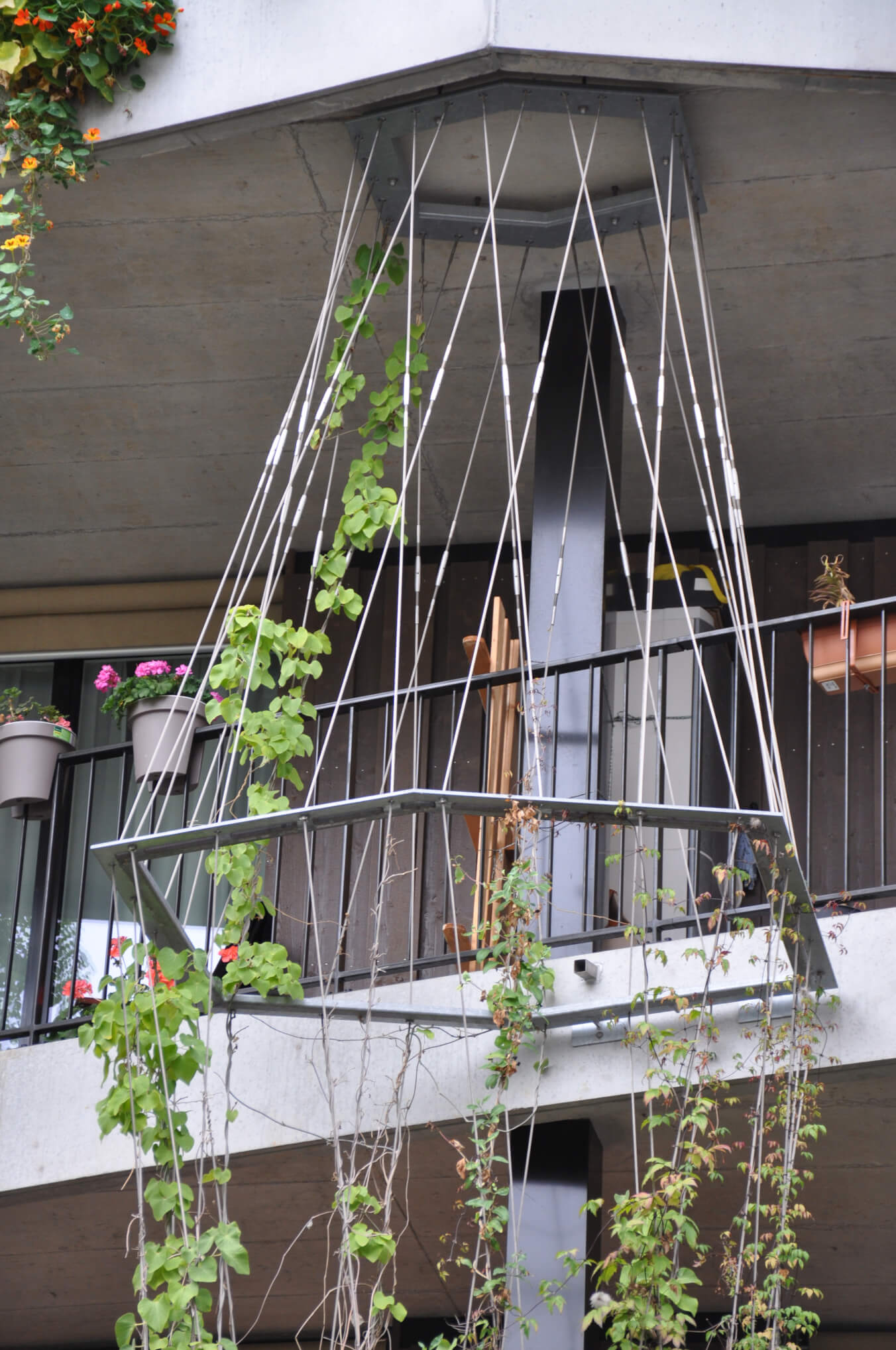
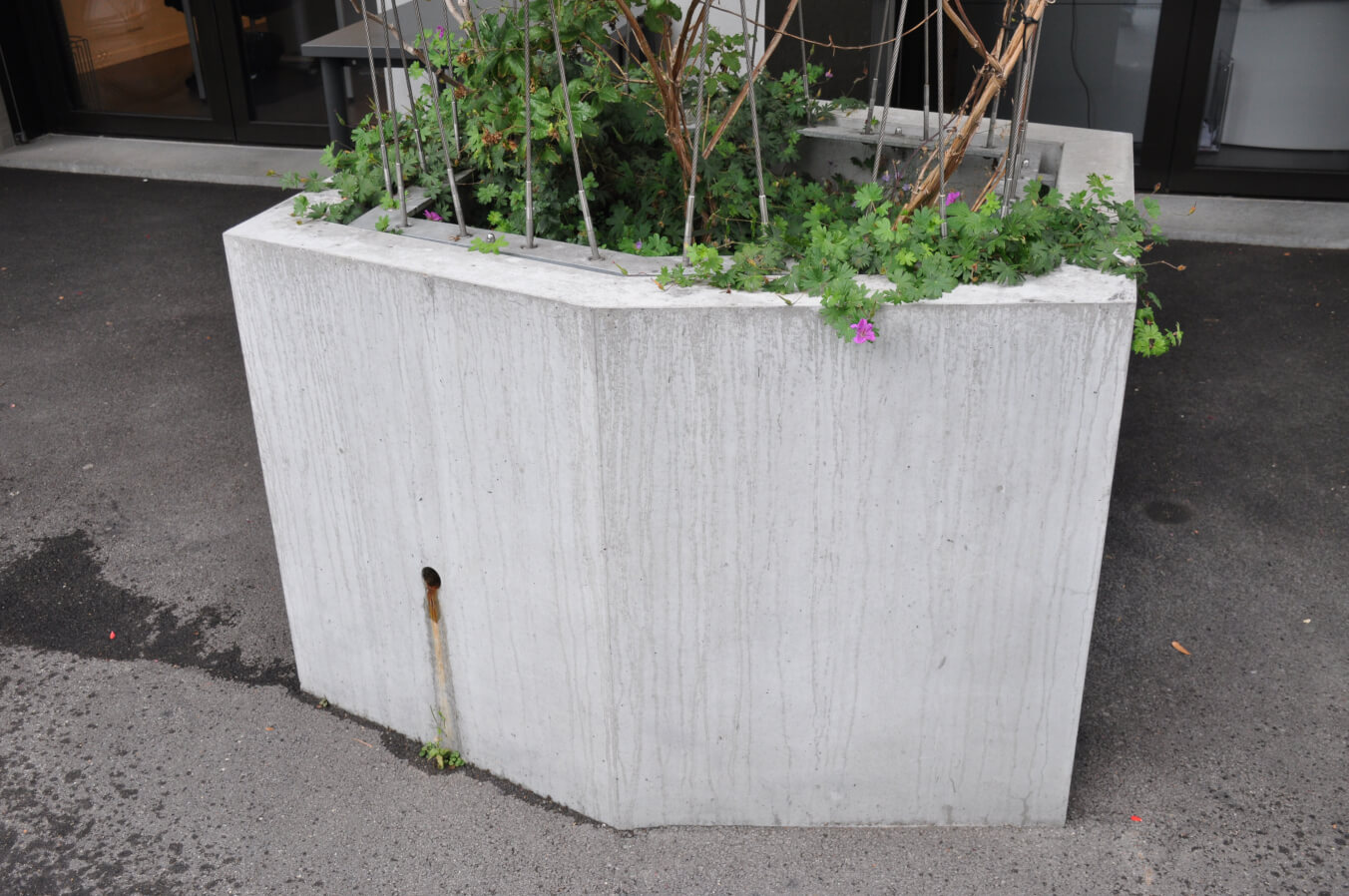
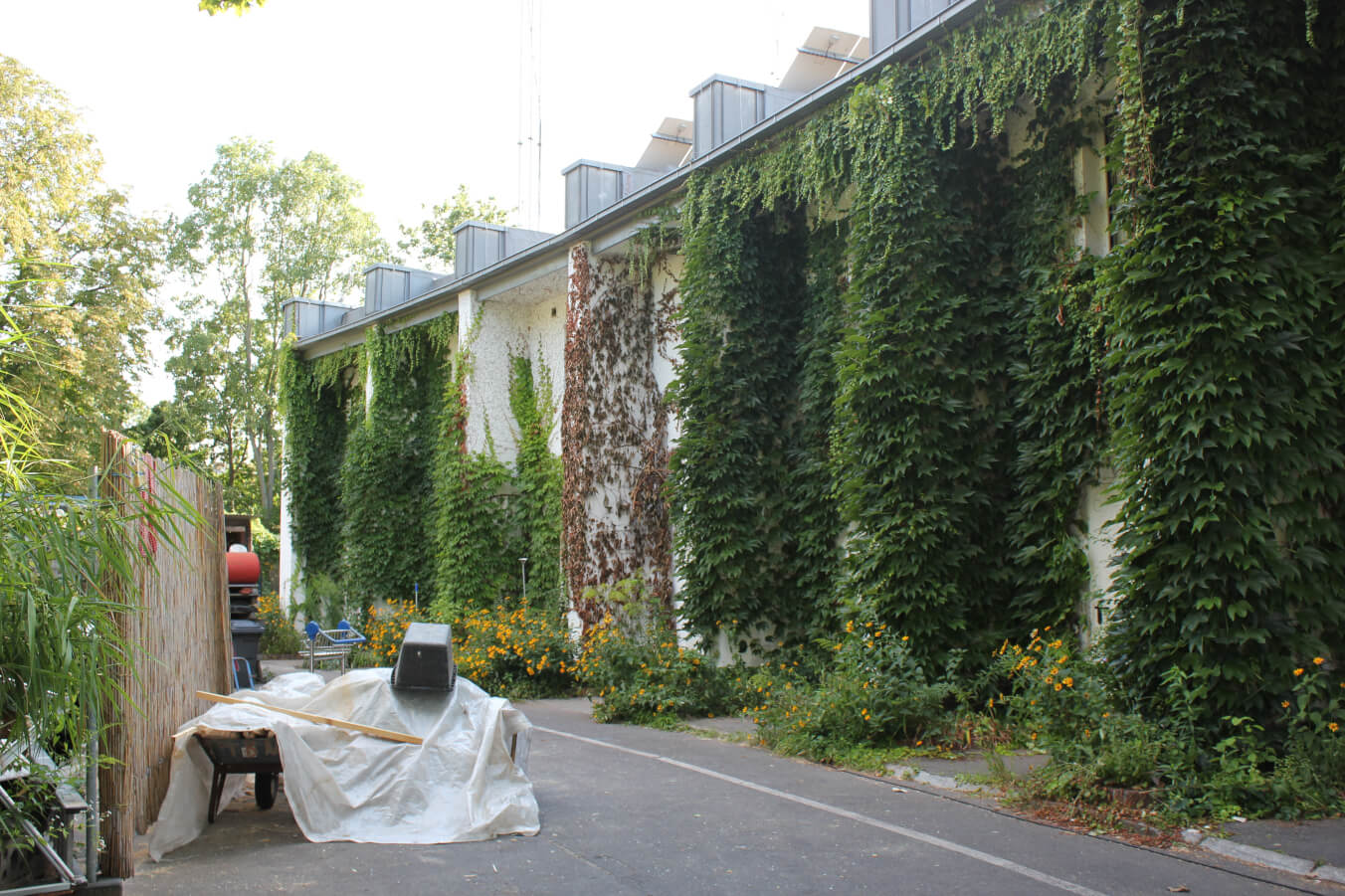
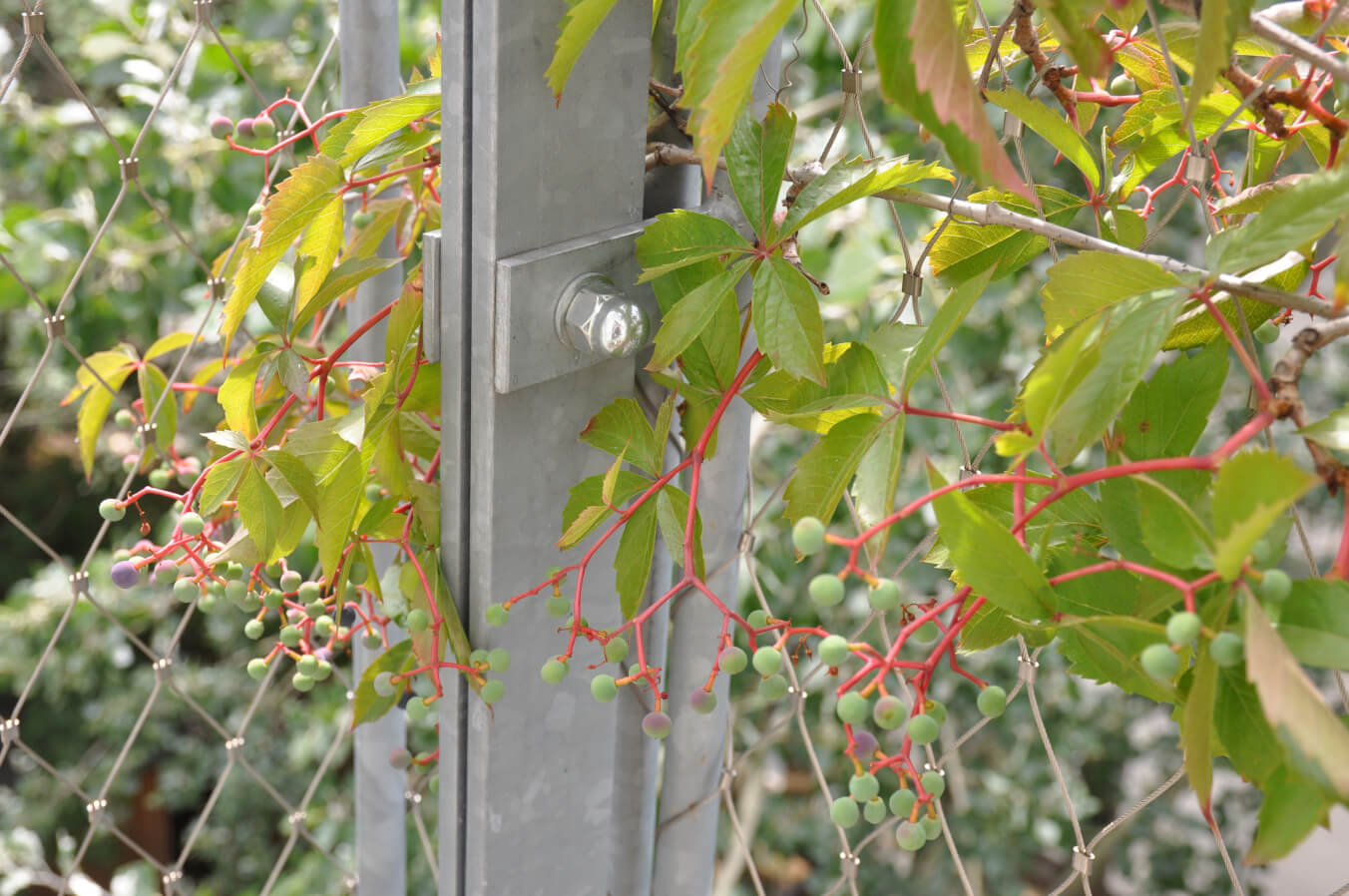
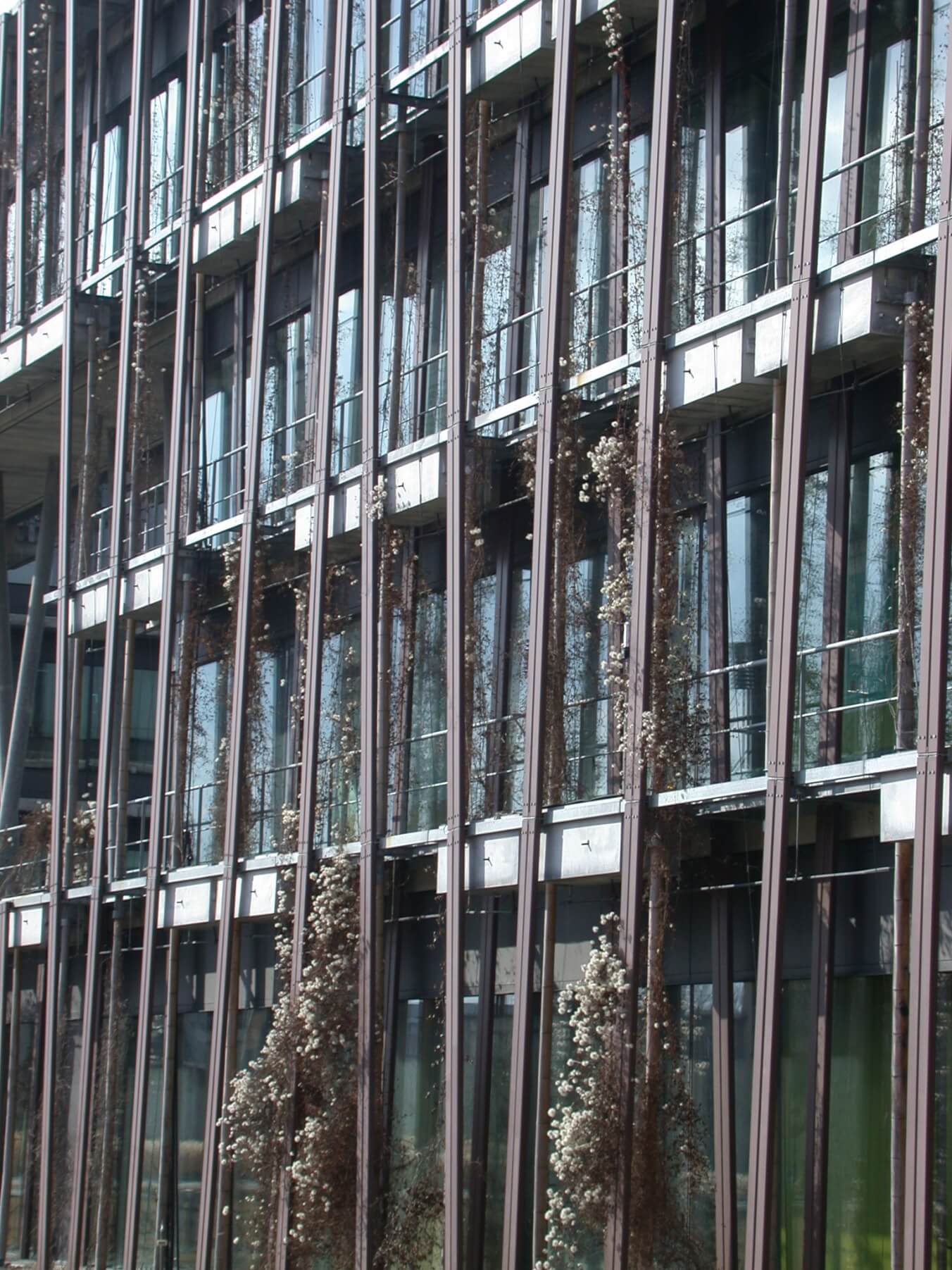
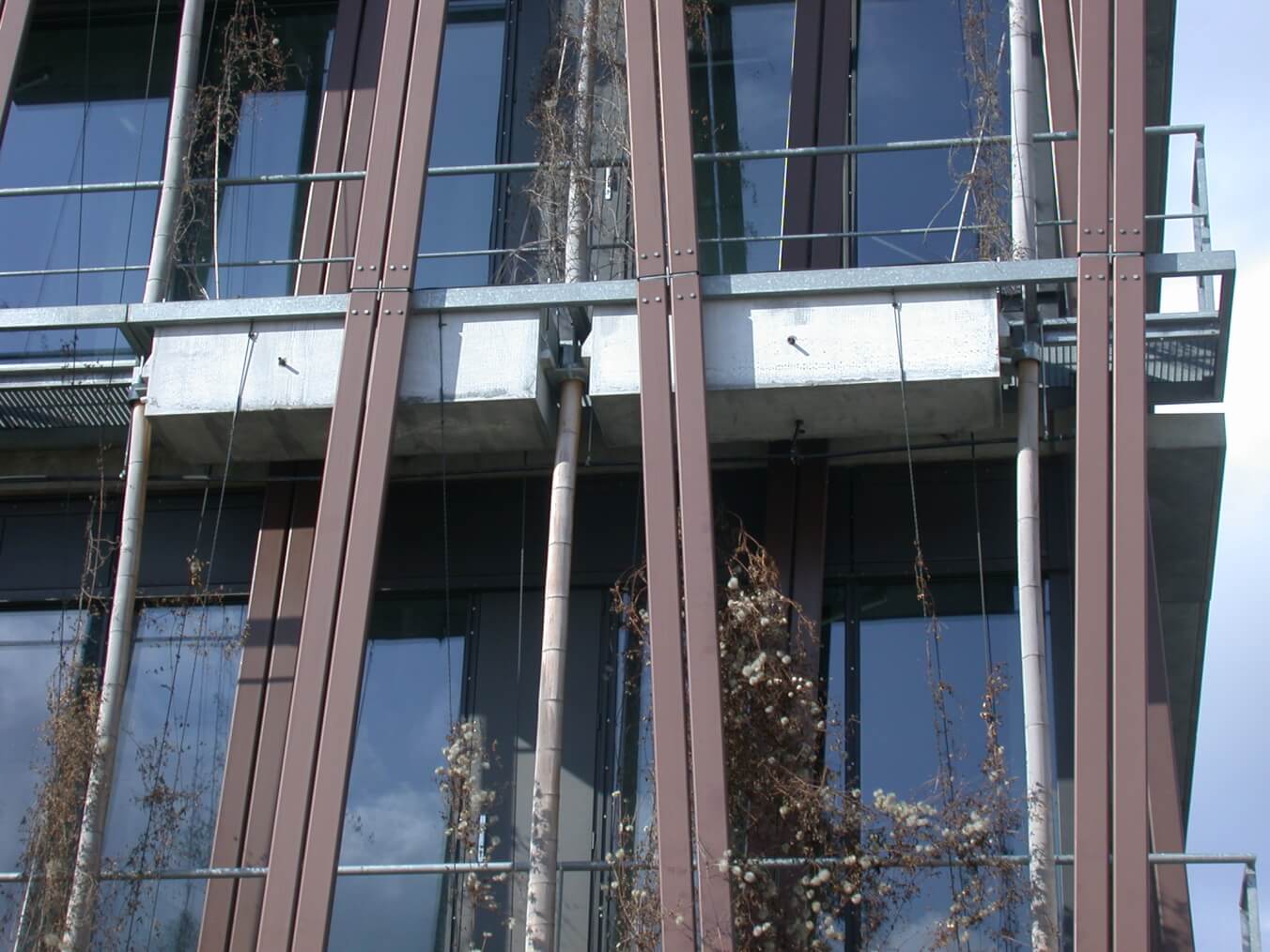
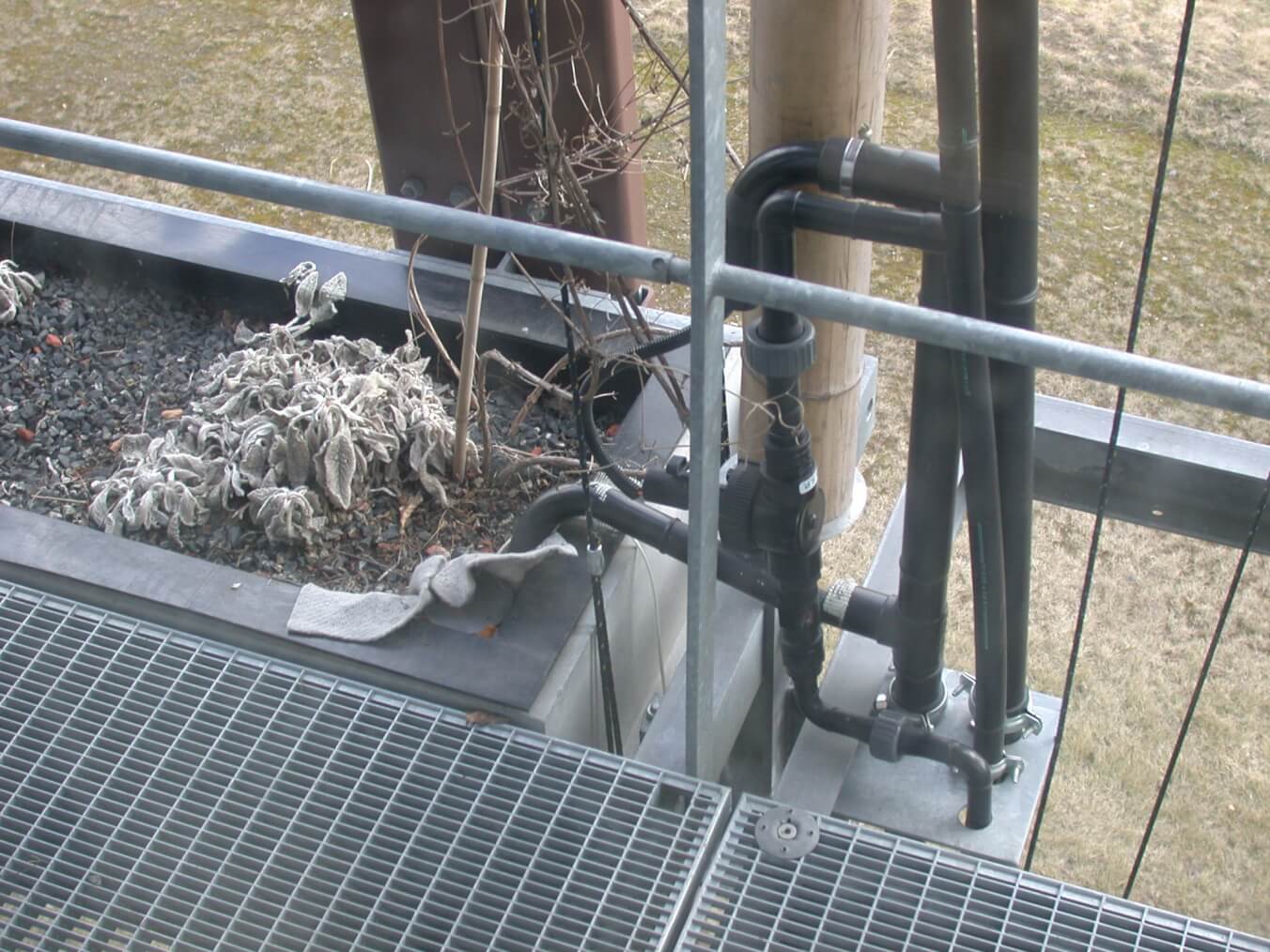
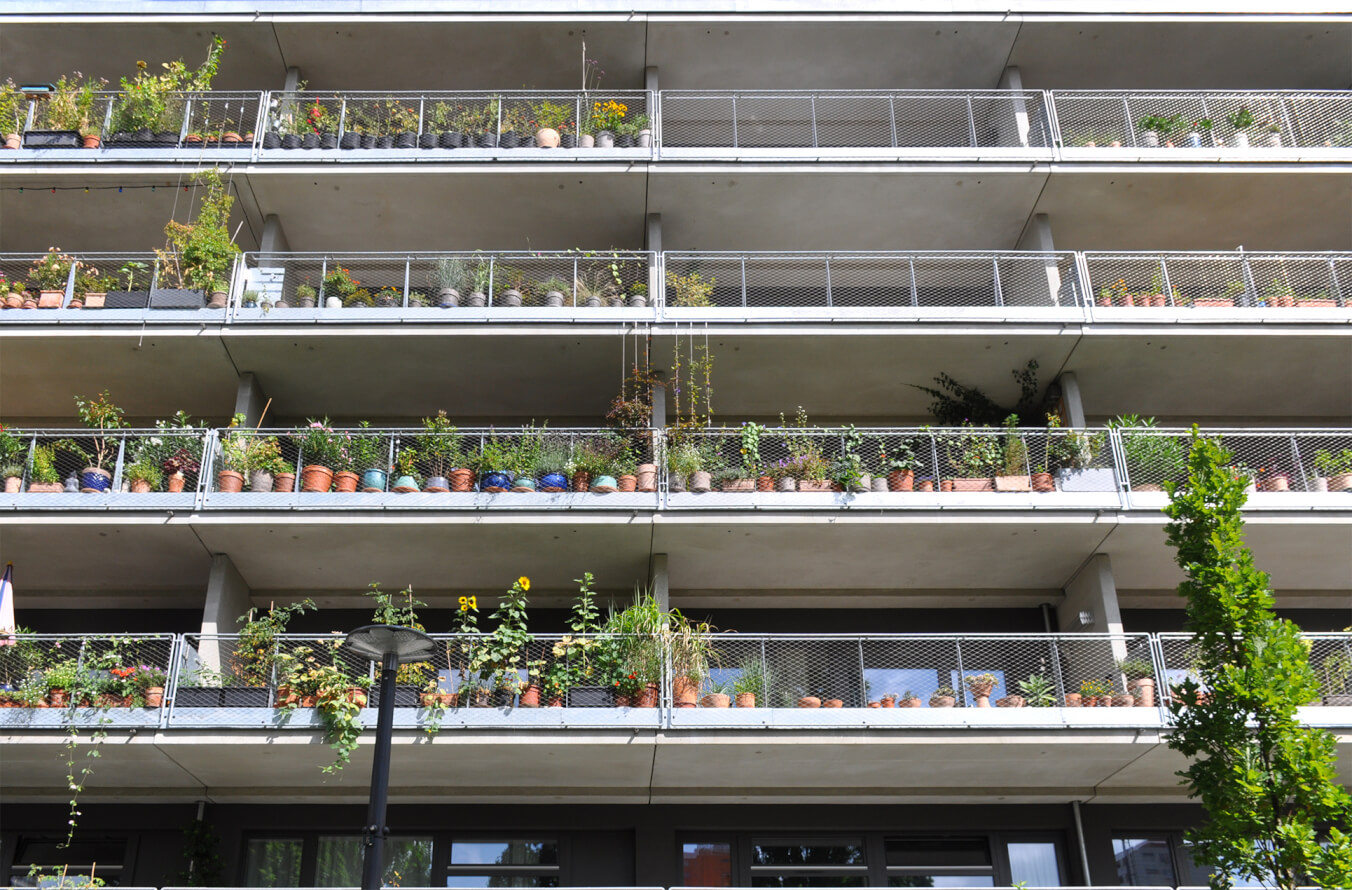
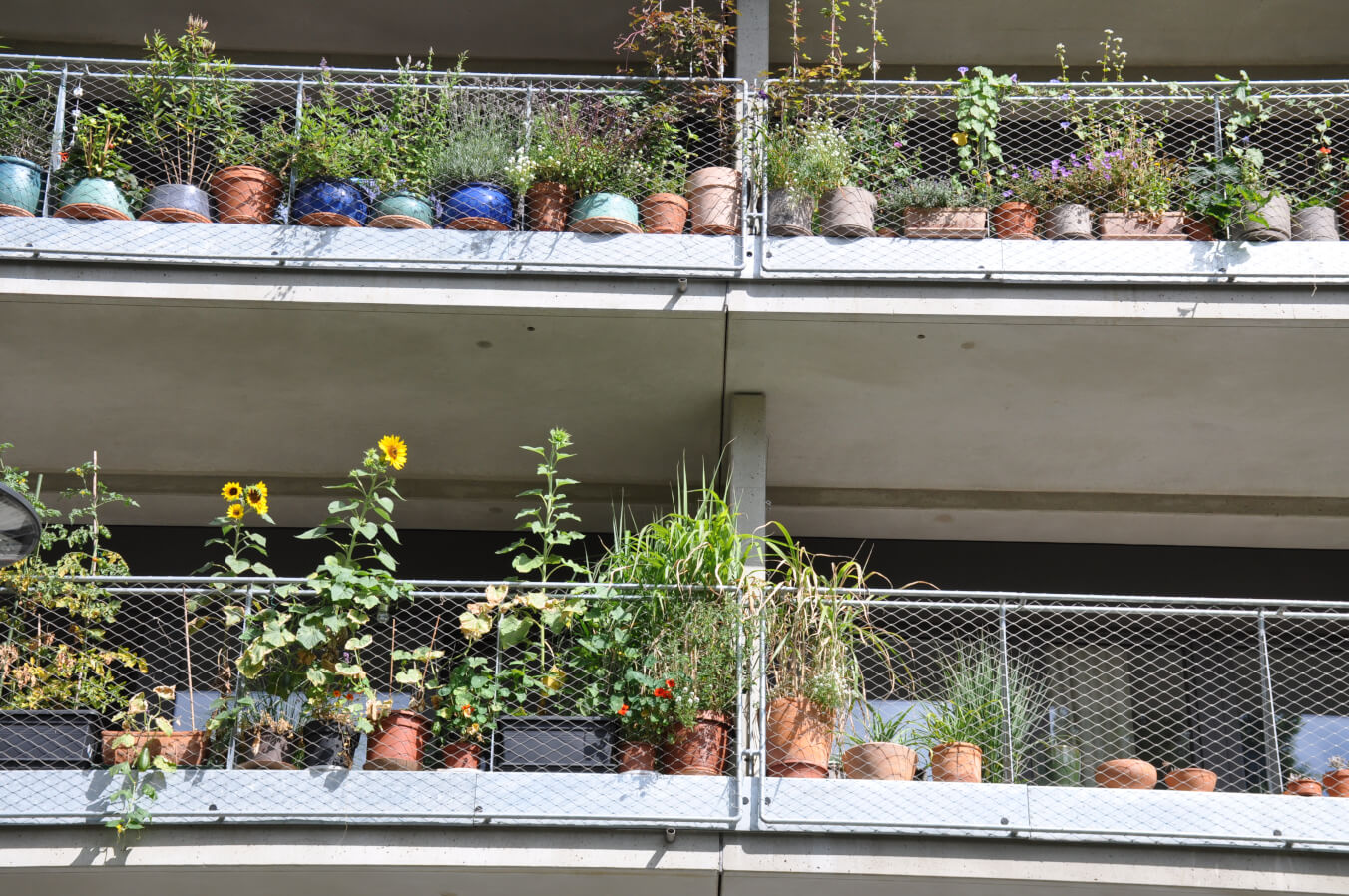
Lessons learned and synergies
An implementation of vertical façade greening on a building significantly reduces the temperature of a building and its surroundings while increasing humidity. Facades thus improve the local microclimate, promote health by reducing air pollution and urban noise, and create ecological niches for animal life in the city. By multiplying rainwater evaporation while reducing heat, the climate balance in the city is promoted and canal systems can be relieved (Pfoser 2016, p. 86). Green facades have the greatest effect in dense cities and hot climate zones. Due to the greening phases, green buildings can simultaneously regulate heat gain and heat dissipation in a natural way (Pfoser 2016, p. 88). They are able to remove 50% of solar radiation from the street space, so they are also beneficial for pedestrian circulation. Cities would benefit from more greenery at street level, as these areas intercept most of the solar gains. At the same time, the average temperature reductions are much smaller than the peak reductions in heat islands (Pauli & Schauermann 2017, p. 55).
Façade greening can be combined with rainwater or greywater harvesting (Pfoser 2016, p. 86). The cooling effect also leads to a synergy in the application of green facades with photovoltaics (PV), as the power output of the PV modules decreases with increasing heating. The combination of solar thermal energy with a green façade, on the other hand, generally has a performance-reducing effect. However, this can be used as a seasonal collector during the heating period (Pfoser 2016, p. 85). Green facades create a link between efficiency, a green infrastructure and a psychological and aesthetic effect.
Sources
Adli, Mazda (2017): Stress and the City. Warum Städte uns krank machen. Und warum sie trotzdem gut für uns sind. Bertelsmann, München.
Baugenossenschaft mehr als wohnen (o.J.): mehr als Aussenraum.
Accessed on 22.02.2021 from https://www.mehralswohnen.ch/hunziker-areal/aussenraum/
Berliner Senatsverwaltung für Stadtentwicklung (Hrsg.) (2010): Konzepte der Regenwasserbewirtschaftung. Gebäudebegrünung, Gebäudekühlung. Leitfaden für Planung, Bau, Betrieb und Wartung. http://www.gebaeudekuehlung.de/SenStadt_Regenwasser_dt.pdf
Hugentobler, M., Hofer, A. & Simmendinger, P. (Hrsg.) (2016): Mehr als wohnen – Genossenschaftlich planen – Ein Modellfall aus Zürich. Birkhäuser Verlag GmbH: Basel.
Internationales Kultur Centrum ufaFabrik e.V (o.J.): Fassadenbegrünung.
Accessed on 21.12.2021 from https://www.ufafabrik.de/de/10569/fassadenbegrunung.htmlInternationales Kultur Centrum ufaFabrik e.V (o.J.): Fassadenbegrünung.
Othman, Ahmad Ridzwan; Sahidin, Norshamira (2016): Vertical Greening Facade as Passive Approach in Sustainable Design. Faculty of Pauli, M. & Schauermann, R. (2017): Messbare Vorteile von Fassadenbegrünungen. In DETAIL green, Ausgabe 1/2017, 56-60, Institut für internationale Architektur-Dokumentation GmbH & Co. KG, München.
Pfoser, Nicole (2016): Fassade und Pflanze – Potenziale einer neuen Fassadengestaltung. TU Darmstadt: Darmstadt. Accessed on 22.02.2021 from https://tuprints.ulb.tu-darmstadt.de/5587/
Schmidt, Marco; Roswag-Klinge, Eike (2020): Regenwassernutzung zur Bewässerung einer Fassadenbegrünung. Ernst & Sohn Special 2020: Regenwassermanagement. Accessed on 12.05.2022 from http://www.bimoka.de/pdf/RWM2020.pdf
